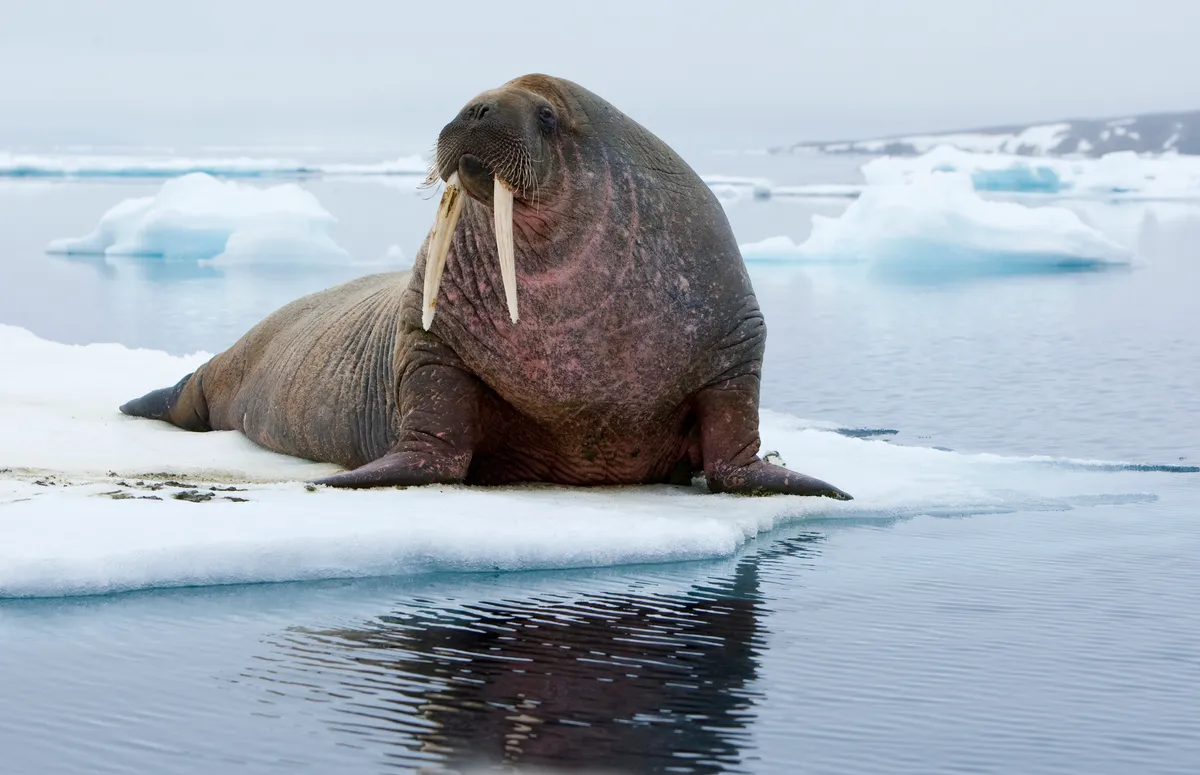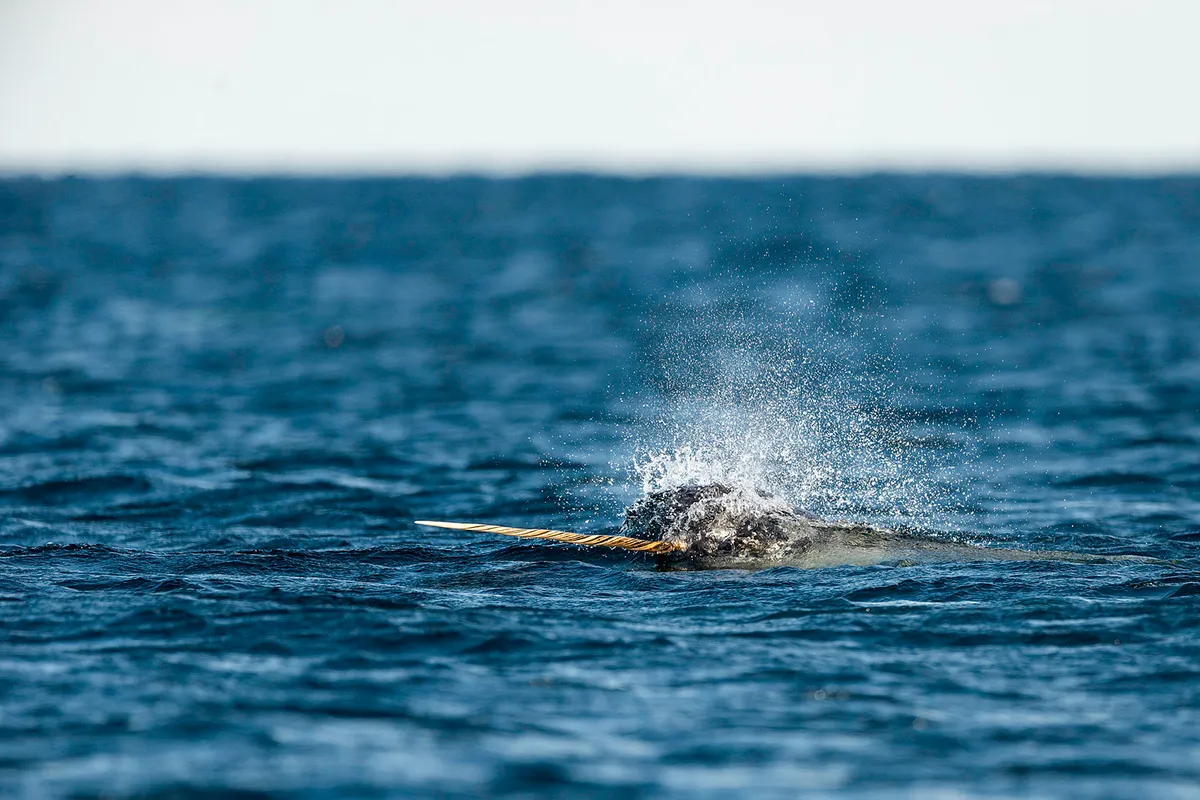Surviving in the Arctic, an inhospitable polar region where temperatures routinely go below -30 degrees celsius and the sea is often covered in sheets of ice, has necessitated various specialised physical and behavioural adaptations, from thick insulating coats to group huddles.
Unlike Antarctica, which is entirely cut off, the Arctic is connected to the continents of North America, Europe, and Asia, meaning that land animals have been able to migrate there.
It also has more plant species and a greater land area. Consequently, the Arctic is home to many more species than its southern counterpart, especially herbivorous land mammals. Read on to learn all about some of our favourite Arctic animals and how they interact with and sometimes depend on each other in this unforgiving climate.
Arctic animals
Polar bear (Ursus maritimus)
No list of Artic animals would be complete without this iconic carnivore. In fact, it is thought that the name of the region itself derives from the presence of these bears, with the word “Arctic” coming from the Greek word "arktikos," which means "near the Bear" (whereas Antarctic, appropriately, means opposite or without the bear).
These huge bears - the largest land predators in the world - are well-adapted for sub-zero temperatures, from their thick layer of fat tissue to their dense coat of white fur that also allows them to blend into their snowy surrounds. Polar bears are also superb hunters, with their excellent sense of smell and swimming skills allowing them to prey on the seals that make up the majority of their diet. The ecological niche they occupy as inhabitants of sea ice is very small, however, meaning that they are very threatened by changes in temperature.
Learn more about the impact of climate change on polar bears
Walrus (Odobenus rosmarus)

One of the many species of marine mammal that can be found in the Arctic’s frigid waters is the magnificently-toothed walrus. Part of the pinniped group, which also includes seals, walruses can grow to quite considerable sizes, exceeded in bulk in this grouping only by elephant seals.
A male walrus can weigh more than 2,000 kilograms. Much of this is made up of a thick layer of blubber which comes in handy given arctic sea temperatures hover pretty consistently just above freezing point. Although a highly sociable animal that lives in large groups, males can get very aggressive with each other during mating season, using their up to 1m long tusks against each other to maintain territory and protect their hareems of females.
Learn all about the growing Arctic cruise ship tourism trend and how eager tourists are flocking to the Arctic to catch a glimpse of iconic animals, including walruses.
Lemming (Dicrostonyx torquatus)

Best known for a persistent misconception that has labelled their migration behaviour as mass suicide, lemmings are small rodents that can be found on, and under, the arctic tundra.
Lemming are primarily herbivores, feeding on mosses, grasses, berries and lichens amongst other things. In the winter, rather than hibernating, they live in large networks of tunnels beneath the snow. As well as keeping them warm, these protect them from predators. These clever tunnels even contain toilet areas, rest areas, and nests made from feathers and musk ox wool!
Like many other rodent species, lemming populations undergo periods of boom and bust, with numbers expanding rapidly, and then dropping low. In peak population times resources are strained, meaning that many have to disperse and move to new pastures, migrating in large groups. This, and the fact that they sometimes either swim or fall into water during migration has led to the myth that they commit mass suicide by jumping off cliffs!
Musk Ox (Ovibos moschatus)

Found primarily in Greenland and the Canadian Arctic, musk ox are very large hooved bovids, standing at about 5 feet tall at the shoulder. They are named for the ‘musky’ odour that males emit during mating season, to attract nearby amorous females.
In Woods Cree (an indigenous Canadian language) their name is even less flattering, translating as “ugly bison”. Surprisingly, given the name, musk oxen are actually more closely related to sheep and goats than they are to oxen, but are placed in their own distinct genus - Ovibos. They are very well adapted to arctic temperatures, with a multi-layered shaggy coat made up of long outer ‘guard hairs’ and a shorter undercoat that provides additional insulation.
Arctic tern (Sterna paradisaea)

This is the only animal on our list that you will be able to spot wild in the British Isles, as in the summer months breeding colonies can be found in northern coastal areas, primarily Shetland and Orkney, but also islands off Anglesea in Wales, and on the Isle of Man.
The ultimate long-distance migrants, they could also be described as Antarctic terns, as they fly from their Arctic breeding grounds all the way to the Antarctic to winter every year, flying a distance of nearly 19,000 miles! Because of this mammoth journey arctic terns see two summers per year, and consequently more daylight than any other animal on earth.
Learn how groups of arctic terns make their epic migration
Wolverine (Gulo gulo)

Found mainly in very northern coniferous forests, but also occasionally further south into the USA, Russia, China, and Northern Europe, wolverines are the largest members of the mustelid family, the group that contains badgers, weasels, and otters among others. These sturdy carnivores are expert and persistent hunters, dispatching prey many times larger than themselves (including deer, sheep, and even moose!).
They are however primarily scavengers, depending almost exclusively on carrion to see them through the lean winter months. They will even take carrion from under the noses of other predators, including wolves, for themselves. This is perhaps why they have earned such a reputation for toughness!
Narwhal (Monodon monoceros)

Arguably one of the most ‘made up’ looking animals out there, resembling as it does as a cross between a dolphin and a mythical unicorn, the narwhal is in fact a toothed whale. Its magnificent “tusk”, that can reach lengths of around 3 metres, is actually a single long canine tooth! Mainly found on males of the species, they use this appendage not as a weapon, but as a sensory organ, a dominance signifier and an adornment.
It has up to 10 million nerve endings inside and can provide the animal with information about their environment including temperature, pressure, and the presence of particles in the water. Like the ostentatious feathers of a male peacock, it is also used to show off their genetic quality to potential mates.
Arctic fox (Vulpes lagopus)
Amongst the most beloved of all arctic animals is the adorable yet tenacious Arctic fox. Found throughout the arctic tundra it has many adaptations that help it to survive the extreme temperatures it experiences. Chief amongst these is its thick and fluffy coat of fur which changes in colour depending on the season - a thinner grey fur in the summer, and the iconic thicker white in the winter, which allows them to blend into their surroundings.
They are also the only canid with fur on the pads of their feet, like built-in snowshoes! When sleeping they use their fluffy tail as a blanket, curling up tightly and wrapping it around their body to prevent heat loss. Their diet consists of pretty much any small animal they can find, from lemmings to seal pups, to seabirds. In the case of lemmings, one of their favourite foods, they often need to go to quite extreme lengths to extract them from their burrows, jumping several feet into the air and nosediving into the snow to catch them!
Greenland shark (Somniosus microcephalus)
The next animal on our list holds the incredible distinction of being the world’s longest-living vertebrate species. This large but slow-growing shark is thought to be able to live to an astonishing 400 years!
The way these sharks are aged is by radiocarbon dating the lens of their eye. Using this method the oldest, and also largest, specimen tested was found to be at least 392 years old, thought to be born between 1504 and 1744! Despite the name, Greenland sharks are not only found in Greenland, but throughout the North Atlantic and Arctic Oceans, and have even been spotted as far south as the Caribbean.
Snowy owl (Bubo scandiacus)
These unmistakable owls can be found soaring above the arctic tundra landscape. Unlike most owls, who hunt at night and sleep during the day, snowy owls are also often active and hunting during daylight hours, particularly in the summer. Like arctic foxes, their diet consists in a large part of lemmings, and their population numbers are thus closely tied to their fluctuating availability.
They cannot breed in high numbers without a good supply of these burrow-dwelling mammals. In fact, an adult snowy owl may eat as many as 1,600 lemmings a year! They are opportunistic hunters, however, and when these cannot be found they do supplement with other birds, rabbits, and fish. These owls are easily identified by their distinctive white plumage with dark markings, large yellow eyes, and substantial body size.
The most famous snowy owl in the world has to be Harry Potter's Hedwig
